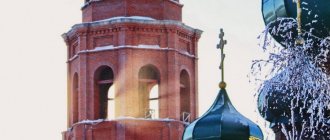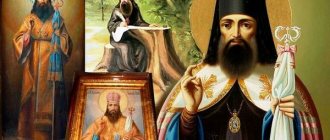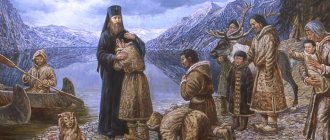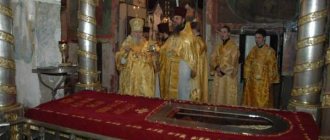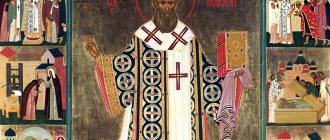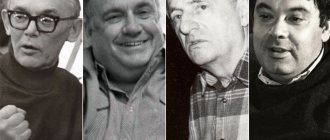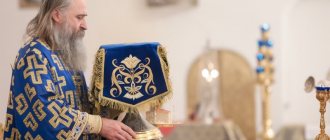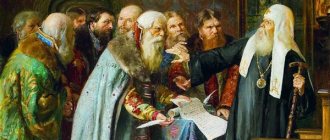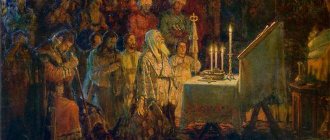"Save me, God!".
Thank you for visiting our website, before you start studying the information, please subscribe to our Orthodox community on Instagram, Lord, Save and Preserve † - https://www.instagram.com/spasi.gospodi/. The community has more than 60,000 subscribers. There are many of us like-minded people and we are growing quickly, we post prayers, sayings of saints, prayer requests, and timely post useful information about holidays and Orthodox events... Subscribe. Guardian Angel to you!
When difficult times come in life, each of us begins to look for our mental and spiritual healing within the walls of churches, temples, and monasteries. This is not surprising, because in this world there is a place for miracles. God sends into our lives his chosen ones, the righteous, people who have a rich spirit, courage and self-sacrifice. They are devotees of faith and love. One of such envoys is St. Tikhon, Patriarch of Moscow and All Rus'.
Parishioners prayed to his image, asking for healing from the most serious illnesses. He heals:
- from cirrhosis of the liver,
- dropsy,
- eye diseases,
- from cholera
- From severe paralysis,
- Healing from bleeding
- Healing children from long-term and incurable diseases.
- Prayer to Patriarch Tikhon of Moscow
Life of Patriarch Tikhon
The saint lived during a difficult time. He had to endure a lot of grief and terrible events. When considering the short life of Patriarch Tikhon, we need to start with his birth.
- He was born in 1865 in the family of a rural priest of the Pskov diocese. In the world he bore the name Vasily. The boy spent his childhood and adolescence in rural labor. Already from a young age, Tikhon was distinguished by a special religious attitude and love for the Church.
- Vasily studied at the Pskov Theological Seminary. His fellow students loved him and had respect for him. The boy was very fast in his studies.
- At the age of 23, he graduated from the St. Petersburg Theological Academy and was appointed to be a teacher at the Pskov Theological Seminary. He was also a favorite in his native land.
- At the age of 26, striving for God with all his pure soul, he became a monk. Almost the entire city gathered to receive Vasily’s tonsure. After which he was given the name Tikhon.
- At the age of 34, Patriarch Tikhon was enthroned and he was appointed vicar of the Kholm diocese. And on September 14, 1898, Bishop Tikhon was sent to serve in the American diocese in the rank of Aleutian.
- Leading the Orthodox Church in America, Tikhon did a lot of different things to spread the Orthodox faith. He also took part in the construction of churches for Orthodox Russian people. It is worth noting that the Americans elected him an honorary US citizen.
- In 1907 the saint returned to Russia. Immediately after his arrival, he was appointed to the Yaroslavl department.
The best article for you, go to: Icon of the Venerable Mary of Egypt
Homecoming and revolution
In 1907, in the rank of archbishop, the future patriarch returned to Russia. He first serves in the Yaroslavl diocese, from which he is transferred to Vilna. In the new place, the local primate gains great respect and love among the entire indigenous population, which consists mainly of Old Believers and Catholics. As before, through his holy prayers, many people convert to the Orthodox faith.
The civil war that preceded the revolution brought a lot of worries to the archpastor. He helped refugees, evacuated the relics of saints from a local monastery, and saved other shrines and icons. I also had to visit the front line, for which Archbishop Tikhon was awarded an order.
Icon of Patriarch Tikhon of Moscow
The February Revolution of 1917 finds the future patriarch in Moscow. Russia is entering an extremely difficult period, characterized by political intrigue. In particular, new authorities and new rules make it possible to electively appoint a primate in Moscow. In previous years, candidates for this position were appointed by the government.
Despite the fact that the Bishop of Vilna was not in honor among representatives of public authorities, the people's choice fell on him. Thus Saint Tikhon was elevated to the rank of Metropolitan of Moscow. Considering the difficult time at which the archpastor took up his new ministry, he was faced with many difficult tasks. Among others, he had to organize a new Local Council, which had not met for more than two centuries.
It should be noted that throughout his life, no matter at what level of the church hierarchy Vladyka Tikhon had to serve, he never called on his flock to rebel against the existing authorities. His dissatisfaction and disagreement with the policies pursued (in particular, in relation to the Church) always had a targeted nature and was aimed at certain actions of specific people.
Vladyka Tikhon always believed that in any system a person can and must save his soul, and nothing external can hinder a person if he sincerely strives for God. Caring for the Church and the flock entrusted to him, the primate more than once had to come into conflict with the authorities. And each time he defended his position from the point of view of the Christian faith, without in any way diminishing the importance of the ruling power in the country. But despite this, he was repeatedly convicted of conducting anti-Soviet agitation.
Years of the Patriarchate of St. Tikhon
Not long after his return, the war began. In 1914, after he was transferred to Vilna, Tikhon made many different donations to various charities. He did everything he could to help the unfortunate inhabitants of the Vilnius region, who, thanks to the war with the Germans, lost their home and means of subsistence.
After the revolution and the formation of the new Synod, Bishop Tikhon became its member. During the congress of laity and clergy, which took place in 1917, he was elected ruling bishop. A little later that year, the Local Council opened in Moscow, and Tikhon, becoming a participant, was elected chairman of the Council.
The purpose of the Council was to restore the life of the Russian Orthodox Church on canonical principles. Also, the Local Council set itself a very important goal, which was to restore the patriarchate; the Patriarch was elected by lot. There were three candidates in total for this position.
After the solemn Liturgy and prayer service on November 5, the schema-monastery of Zosimova Hermitage took out one of the three lots with the name of the candidate from the reliquary. He turned out to be Saint Tikhon, Patriarch of Moscow. Despite the fact that he was entrusted with the leadership of the Church, the Patriarch did not change and was an approachable and kind person. But the gentleness in the saint’s character did not prevent him from being firm in church affairs. Because it was necessary to protect the Church from enemies.
It is worth noting that the years of the patriarchate were quite difficult, because they fell during a period of general church ruin. In addition, the whole situation was complicated by many external circumstances. At that time, there was just a change in the political mood, there was a civil war, there was famine, etc. This was a time when the clergy was persecuted and persecuted. The Church was persecuted by massive repressions.
Saint Tikhon called on the people to serve God. He was able to gather together the drained forces of the Church and inaugurate the great beginning of revival through repentance. His life was an example for everyone.
Arrest of Patriarch Tikhon
In 1922, the authorities began to take away their values from the churches. At the same time, the authorities sought to strengthen the renovationist “church,” which was created by a group of adventurers. It was created to create the appearance of spiritual freedom. The legitimate Patriarch Tikhon was accused of carrying out counter-revolutionary activities.
Such an accusation was brought against the patriarch, obviously, because in mid-1921 he joined the created famine relief committee. He called on all church and parish councils to donate church values to the benefit of the needy population.
The best article for you, go to: Icon of the Unbrided Bride, what does it help with?
In May 1922, it was announced to the saint that he would be kept under arrest. The head of the Church was imprisoned as a “witness.” He was accused of supporting high treason. At the end of 1923, Patriarch Tikhon was released.
The Patriarch endured all the hardships and struggles of the church very painfully. All the church upheavals, constant work to eliminate and pacify church life, sleepless nights, imprisonment, persecution from enemies undermined his good health.
Beginning in 1924, the Patriarch began to get very sick. In mid-spring 1925, he served his last Liturgy and two days later he died. It is said that in the last moments of his life he turned to God.
Almost a million people came to say goodbye to Patriarch Tikhon of Moscow. The large cathedral of the Donskoy Monastery in Moscow could not accommodate those who said goodbye for a hundred hours.
Throughout his life, Patriarch Tikhon of Moscow did a lot of good deeds for the church. He did a lot of work to strengthen the Orthodox faith during difficult years of trials.
To Tikhon Zadonsky
“God is wonderful in His saints...” (Psalm 67:36).
There are many saints in Rus'. And each of them shone in its own way, just as different precious stones shine differently. Every person can find a saint “close” to him. In our family, one of the most revered is St. Tikhon of Zadonsk. The future Saint Tikhon of Zadonsk was born in 1724 in the village of Korotsk, Novgorod province, into the family of a sexton and was named Timothy. His father died so early that Timofey did not even remember him. The mother was left with six children: Timofey had 3 brothers and 2 sisters. The elder brother took over his father's position. On his meager salary and on what he managed to help out his mother, who worked from morning to night, the family lived very poorly, often without even enough food. Later, Saint Tikhon told his cell attendant: “...And since there was nothing to eat in the house, I used to harrow the arable land with a rich man all day long, so that only the rich man would feed him bread.”
It is not difficult to imagine the agony of a mother who has nothing to feed her children. One day she was faced with the temptation to give her child a better life. A rich childless coachman lived nearby. He really liked little Timofey. And the coachman began to persuade his mother to give Timofey to him. He promised to adopt him, educate him, “all my property will then be his.” The mother did not agree for a long time, but one day, not having a crumb of bread in the house, she took Timofey by the hand and led him to the coachman. On the way, the mother was caught up by the eldest son: “Where are you taking your brother?... I’d rather go around the world with my bag, but I won’t give my brother to the coachman - we’ll try to teach him to read and write, then he can choose which church to become a sexton or sexton!” And mother and son returned to the hungry house.
In 1738, Timofey was enrolled in the Slavic Theological School in Novgorod. In 1740, among the best 200 students, he was employed at the Novgorod Theological Seminary at public expense. But what kind of government support was this? Daily piece of bread. Saint Tikhon remembers this this way: “... when I receive government bread, then I will keep half of it for food, and I will sell the other half and buy a candle and with it I will sit at the stove and read a book. The children of rich fathers, my fellow disciples, play or find the furnaces of my bast shoes and begin to laugh at me and wave them at me, saying: “We magnify you.”
Despite all the difficulties, Timothy was one of the best students at the seminary. He excelled so much in Greek that he began teaching it at the same seminary without even graduating! After graduation, he was a teacher of rhetoric and philosophy for some time. In the spring of 1758, he took monastic vows with the name Tikhon. In the summer of the same year he was ordained a hieromonk. In 1759, Tikhon was appointed rector of the Tver Seminary and teacher of theology. But a new, even higher field awaited him...
In 1761, on Easter Day, in St. Petersburg, members of the Holy Synod elected a bishop to Novgorod. One of seven candidates had to be chosen by lot. The Smolensk bishop proposed to also attribute the name of the Tver rector Tikhon. The first present of the Synod said: “Still young...”, but he wrote down his name. The lot was cast three times and each time Tikhon's lot fell out. “It is true, God so desires that he be a bishop,” said the First Present. Saint Tikhon later spoke about this: “I never even thought about this important rank, to be a bishop, and my thoughts were certainly to retire somewhere to a deserted monastery and spend a solitary life... But fate so pleases the Almighty that I am unworthy - bishop."
The people of Novgorod greeted the new bishop with love, as he had once been a student and then a teacher of the Novgorod seminary. Many priests and deacons of Novgorod once studied with him and mocked little Tima, waving their bast shoes at him like a censer. Now they had to burn incense on him with a real censer during the bishop's services.
Saint Tikhon did not remain at the Novgorod See for long. On February 3, 1763, Empress Catherine II appointed him Bishop of Voronezh.
This appointment was not easy. The diocese was considered “wild”: semi-pagan morals, Cossack freemen, not only the people, but also part of the clergy were ignorant. Saint Tikhon complained: “Many priests and deacons come to me who are extremely ignorant of the Gospel and the Apostle of Honor. Without reading the New Testament it is impossible to know the will of the Heavenly Father, and without knowing it it is impossible to fulfill it, and from failure to fulfill His holy will, obvious destruction follows. For this reason, all clergy found in the diocese are ordered to have the New Testaments with them. Read them with reverence and diligence.” Enlightenment became one of the main tasks of the saint. He composed instructions for priests and wrote sermons for reading in churches. He opened Slavic schools in all cities of the region, and a theological seminary in Voronezh.
But Saint Tikhon was not only concerned with enlightenment. Having experienced poverty and need, he strove with all his heart to help the suffering. According to the recollections of cell attendants, “Poor people always had free access to it. His sensitive heart was not so passionately occupied with any subject as with helping poverty and consoling sorrow.” “The activity of the saint extended to the point that he was never idle, and when any preparations were required for his pastorate, he often spent whole nights without sleep and could not calm down until he finished his work...” The people loved their shepherd. They said about him: “We must obey him, otherwise he will complain to God.”
Saint Tikhon's service as Bishop of Voronezh turned out to be short-lived, only 4 years and 7 months. But during this time he managed to do much more than many others before and after him. His health, both moral and physical, was completely undermined. Not wanting to perform his duties poorly, he submitted a petition to the Holy Synod for dismissal from office and permission to choose a monastery for his residence. His request was granted and Saint Tikhon moved to the Tolshevsky Monastery. The swampy terrain on which the monastery was located further worsened the saint's health, and he was forced to move to the Zadonsk monastery.
It was from the cell of the Zadonsky Monastery that the greatest spiritual writer, the “Russian Chrysostom” - Tikhon of Zadonsky, shone throughout the country with his creations. Many generations of Orthodox Christians were brought up on his books “On True Christianity”, “Spiritual Treasure Collected from the World”, and others. And in our difficult times, the saint’s books not only have not lost their significance, but have acquired even greater relevance. We can fully draw from them the greatest treasures of thought that lead us to the knowledge of truth.
In addition to unceasing prayer, reading and writing soul-helping books, Saint Tikhon did not abandon acts of mercy for his neighbor. Cell attendants recall: “He spent almost his entire annual pension on charitable causes; and left the smallest part for myself...” Of the money and supplies generously sent to him by rich admirers, he distributed almost everything to the poor, orphans, widows, old people... “The poor, hearing about his mercy, flocked to him from all sides, explained their needs and asked for help, which they received.”
The saint also taught his spiritual children mercy: “Many think of being something, often read prayers, fast, build temples of God and decorate them (which in itself is commendable and shows the appearance of piety); but when someone who is poor and in need of help touches them, he is deceived, just like someone who touches a cold stove, although he wants to warm up from it, and so leaves with the same sadness and misfortune with which he came.” “Many do not eat meat, fish and other foodstuffs, but devour people alive.”
However, Saint Tikhon always remembered that spiritual mercy is higher than material mercy. He “had the gift of a healer of the ulcers of the soul, a comforter, a wise mentor, a peacemaker.” Not only in words, but by his own example, he showed how we must be able to forgive, not be offended, not condemn - how to meekly accept everything sent to us. It happened that life was hard for him in the monastery. Under Abbot Nifont, a letter was sent to the Holy Synod asking whether Bishop Tikhon could be allowed to perform divine services. The Synod recognized the question as inappropriate and strongly recommended that he be provided with everything necessary for his ministry. However, despite this direct instruction, the proper conditions for St. Tikhon to perform the liturgies were not created. Abbot Theodosius, who replaced Nifont, also had a very unfriendly attitude towards the saint (once, while still Bishop of Voronezh, Saint Tikhon removed him from one of his posts “for negligence”). Abbot Samuel surpassed everyone: he not only publicly spoke ill of the saint: “He, a bishop, lives with me worse than a monk,” but he even dared to raise his hand against him.
It is worth noting that among the admirers of St. Tikhon were the most prominent archpastors of Russia, and if he had complained, any ill-wisher would have lost his place. But Saint Tikhon of Zadonsk was primarily guided by the principle “forgiveness is better than vengeance.” The saint’s cell attendant spoke about this: “He, the Eminence, do you believe, had such properties of soul that when he was scolded, reviled, defamed, slandered, he only wept bitterly about such, regretting them, he blamed everything on the enemy of God and the Christian , the devil. And when one of these, having felt himself, with an admission of guilt, asked him for forgiveness, it happened that he would embrace him with joyful tears, kiss him and forgive him from a heart filled with love.” And even more than that, learning about new slander, the saint only sighed and said to the cell attendant: “Take a head of sugar, a barrel of grape wine, take it to the chief; maybe he doesn’t have it.”
Well, which of us, hand on heart, can react in the same way to the actions of our superiors? No one. We all have a sense of self...
Looking at the authorities, many monks also annoyed the saint. And the saint accepted these insults with the words: “... even though I could take revenge on them and make them unhappy, I don’t want to do this. The Lord told us: “Love your enemies and bless those who curse you.” “God so pleases that the ministers laugh at me, and I deserve this for my sins, but that’s not enough...” The cell attendant says: “The monks who annoyed him at times became sick: he visited them two or three times every day, consoled and encouraged them with his prudent and soul-helping conversations, and also provided them with food and drink.”
Saint Tikhon had another way out of this situation. Metropolitan Gabriel earnestly invited him to move to the Novgorod diocese, where he promised to find a monastery worthy of the saint. The temptation was great, but Saint Tikhon did not succumb to it. He remained in the Zadonsk Monastery until the end of his life, patiently enduring all trials.
Tikhon Zadonsky died at the age of 59 on August 13 (26 according to the new style) 1783 in the presence of only four cell attendants. As soon as the news of the death of Saint Tikhon spread throughout the surrounding area, the monastery became overflowing with people and was filled with tears.
Saint Tikhon was buried under the altar of the Church of the Most Holy Theotokos of Vladimir on August 20, 1783. After the burial of the saint, the ruling Bishop of Voronezh, Tikhon III, who greatly revered his predecessor and sincerely shared the general grief, said many warm words, and, in particular: “Remember that he was like Job the righteous: an eye to the blind, a leg to the lame, clothing to the naked, the hungry food, refuge for all those who mourn, reinforcement for the weak, comfort for the sad, healing for spiritual exhaustion. From now on, when you weep under the burden of misfortunes, when you are aggravated by illness, you will be left without a comforter and helper; when you melt from hunger, wander without cover, grow cold without clothing, then your Tikhon, who once sought you himself, will no longer come to you.”
The flow of people to Saint Tikhon not only did not diminish with his death, but intensified even more. Numerous healings took place at his grave. The people, who revered him as a saint during his lifetime, became even more convinced of this after his death.
In 1845, construction of a new Vladimir Cathedral began in the Zadonsky Monastery. The old cathedral, under whose altar Saint Tikhon rested, was dismantled. The saint's body was found incorrupt. The bishop's vestments, despite such a long stay in a damp place, were also intact. The new coffin with the relics of the saint was temporarily, until the completion of the construction of the Vladimir Cathedral, buried in the warm Church of the Nativity of the Mother of God of the monastery. Documents were sent to the Holy Synod and the Sovereign Emperor confirming the discovery of the holy relics incorruptible, and petitions to canonize the saint of God, Tikhon of Zadonsk, revered by all of Russia. But a lot of time passed before this was destined to come true. For various reasons, the case was delayed. And so, only in 1861, the Holy Synod sent a report on the case of the glorification of St. Tikhon to the reigning Emperor Alexander II for signature. The Emperor wrote in his own hand on the report: “I agree with the opinion of the Holy Synod. Alexander". The official glorification of Tikhon of Zadonsk as a saint and the opening of his relics for public veneration were scheduled for August 13, 1861, the feast day of St. Tikhon.
The small town of Zadonsk was preparing for this great holiday. A large number of pilgrims were expected, for which old premises were equipped and new ones were hastily built. In the chronicle of events we find an interesting fact. “In the city there is a street lined with stone and wooden inns. Their owners, counting on a large crowd of people and wanting to take advantage of this for their own benefit, came together and agreed to rent out the rooms for a high price; one of them, having been invited, did not approve of their intentions and was not at the council... The next day after that there was a fire... The fire... spread to the inns and destroyed them all to the ground, with the exception of the house standing next to them, the owner of which was not participated in the wicked council." Truly, “Blessed is the man who does not follow the counsel of the wicked...” (Psalm 1:1)!
The city of 7,000 people had to accommodate 300,000 pilgrims. There weren't enough rooms. Those who arrived in carts and wagons lived in them. Those who arrived on foot settled down right on the ground. Despite the inconvenience, there were no quarrels or fights. On the contrary, the city was quiet and pious. The reading of prayers and akathists could be heard from everywhere. On the day of glorification, “The entire monastery courtyard, all the roofs and fences of various monastery buildings were humiliated by the people. The high monastery bell tower, with all the projections, gratings and openings standing on its roof, looked like a decorated living pyramid of people... The sharp monastery fence, several arshins high, was also studded with people who sat on it, holding each other. One cannot help but marvel at the zeal and patience of the common people: they occupied these places, too uncomfortable for sitting, from five and six o'clock in the morning, and sat on them continuously until two o'clock in the afternoon. In the large monastery garden, people sat on trees and hung, holding onto branches. In the city, the tiled roofs of many houses were dismantled and people were placed in the attics; they were kneeling on the rooftops, all with burning candles. The whole solid mass of the people seemed to represent one body, imbued with the same spirit of love and zeal for the saint and gratitude to God, glorifying His saint.”
Since then, the Zadonsky Monastery has become one of the most popular places of pilgrimage. People flocked to the beloved saint from all over Russia. But after the revolution of 1917, both this holy place and the holy relics themselves suffered a lot of grief.
In January 1919, the relics of St. Tikhon of Zadonsk were desecrated. In order to turn people away from the faith and discredit church ministers, the Cheka conceived and carried out an “operation to open the relics.” There was even a “documentary” film made in which they showed something made of cotton wool and cardboard allegedly removed from the crayfish - the official report on the results of the “autopsy” indicated that a “roughly made doll” was discovered. (In 1959, the relics of St. Tikhon were re-examined in Orel by a commission of church ministers and doctors. The results of the examination completely refuted everything recorded in the “autopsy report” of 1919).
The monastery was literally plundered. Everything valuable, including the silver shrine of St. Tikhon, was confiscated. The relics themselves were recognized as “not subject to removal” and were left to the “collective of believers.” In 1929 the monastery was closed.
In 1932, the relics of St. Tikhon of Zadonsk were transferred to the anti-religious museum of Yelets, and then transported to the Oryol Museum of Local Lore, where they remained until the Great Patriotic War.
During the war, when Oryol was captured by the Germans, the clergy turned to the city commandant Adolf Hamann with a request to open churches. The first to be opened was the Epiphany Church, in which the relics of St. Tikhon of Zadonsk were placed on the high place of the altar. They remained there until 1961. With the beginning of repeated persecutions of the church under N.S. Khrushchev, the relics again ended up in the storerooms of the local history museum.
The Russian Orthodox Church managed to finally return the shrine only in 1988 (on the occasion of the 1000th anniversary of the baptism of Rus'). And the relics returned to their place - under the arches of the Vladimir Cathedral of the Zadonsk Monastery - on August 13/26, 1991. As once upon a time for the discovery of the relics of St. Tikhon, a huge number of people gathered in Zadonsk for their return.
“The shrine found peace in a specially constructed shrine under a canopy, overshadowed by an icon depicting the saint, preserved through the efforts of believers and clergy - the only one remaining from the former icon wealth of the churches of the Zadonsk Mother of God Monastery.”
I would also really like to add a little about the Zadonsky Monastery itself - one of the oldest monasteries in Russia. The history of the foundation of the Zadonsk Monastery is as follows.
Back in 1395, Tamerlane and his army marched on Moscow, leaving behind only ashes... This threat was more terrible than all the previous Tatar-Mongol invasions. They trusted only in God and the Most Holy Theotokos. Moscow Prince Vasily Dimitrievich (son of Demetrius Donskoy) ordered the miraculous icon of the Most Holy Theotokos (which has since become known as the Vladimir Icon) to be brought from Vladimir to Moscow. On the day of the meeting of the icon in Moscow (Candlemas), August 26 (September 8, New Style) 1395, a miracle happened. The Mother of God, surrounded by Moscow saints and the heavenly army, appeared to Tamerlane in a dream and ordered him to leave the Russian land. Tamerlane turned his troops around and left! And at the place where the icon met, Muscovites founded the Sretensky Monastery.
Around 1610, two natives of the Sretensky Monastery, monks Kirill and Gerasim, taking with them a copy of the miraculous prototype of the Vladimir Mother of God, came to the Don, to these then still wild places. Perhaps because somewhere here there was an appearance of the Most Holy Theotokos to Tamerlane. On a beautiful Don hill, not far from the road from Yelets to Voronezh, they founded the Teshevsky Monastery, later renamed Zadonsky. The main temple of the monastery became the temple in the name of the Presentation of the Vladimir Icon of the Mother of God.
The icon of the Vladimir Most Holy Theotokos, with which Cyril and Gerasim came from Moscow, also turned out to be miraculous. In 1692, a terrible fire destroyed the entire monastery with all its property - and only this image was found intact on the ashes. Unfortunately, during the church pogroms of the 1930s, this icon was lost. But according to the description of the icon by an eyewitness, Hieromonk Gerontius, it became possible to make a fairly accurate list, which is now in the Vladimir church of the monastery.
We have long had a desire to visit the Zadonsk Monastery and venerate St. Tikhon of Zadonsk. In January 2009, when my husband was on Christmas break from work, we finally got ready to go on the road. We received a blessing for the trip from the priests of our church, and a large bag of fruit as a gift to the monastery from the Sunday school. Just before we left, our whole family prayed - we read all the prayers for travelers that we could find, and asked St. Tikhon to bless us to visit his monastery. We are sure that this is why we arrived safely - the road was disgusting. We left a little late - around 1 o'clock in the afternoon. It got dark quickly. The Moscow-Don highway under construction is very narrow in some places, and in some places there is no lighting. In addition, heavy snowfall interfered. There were many accidents on the road, so we had to drive slowly, and sometimes just sit in traffic jams. Initially (at home) we planned to arrive in Zadonsk around 6 pm, check into a hotel and go to the monastery. However, when, in fact, at about 7 pm we were still very far from the goal, panic slowly began to seize us...
We entered Zadonsk around 8 pm and immediately headed to the monastery. There was only one fear - that we were late and the monastery was closed. We decided not to waste time on the hotel - we simply prayed to Saint Tikhon and hoped that he would not leave us to spend the night on the street. They were still allowed into the monastery - there was about an hour before closing. We almost ran to the temple.
The Vladimir Church simply amazed us: it itself is of extraordinary beauty, and now it was also decorated for Christmas with several huge, right up to the vaults, decorated fir trees and many small fir trees. In a prominent place stood a nativity scene with the newborn Savior skillfully woven from fir branches... It is impossible to convey this beauty in words.
Due to the late hour and non-holiday day, the temple was practically empty, which was a great joy for us. We approached the shrine with the relics without any fuss and haste, which are inevitable in a queue, then we stood and prayed nearby, without being distracted by anything. After some time, several nuns approached the shrine, for whom the shrine was opened. The nuns did not touch the glass, but the veil on the saint’s head. We stood nearby in silence, looked, but didn’t dare approach... The cancer room was closed again.
A woman performing some kind of obedience in this temple completely unexpectedly came up to us and said: “Ask, they will open it for you too.” But we would not dare to do this! Then she herself turned to the monk standing next to the shrine and asked for us. And they really discovered cancer for us! Our whole family reverently venerated the shrine. At that same moment, there was a feeling that it was worth coming here just for this reason.
I didn’t want to leave the temple, but the monastery was closing. Having learned the schedule for tomorrow's morning service, we, no longer in a hurry, headed to the hotel. The only available room was waiting for us at the hotel, and it was exactly what we needed for the three of us with our daughter...
The next morning - joy again. It was a bishop's service! Bishop Nikon of Lipetsk and Yelets served as the Holy Archimandrite of the Zadonsk Nativity of the Mother of God Monastery, who did a lot for its revival. The temple was simply packed with people - it was hard to believe that last night there was almost no one here.
We were planning to leave immediately after the service: we wanted to visit two more miraculous springs, and there was a difficult, many-hour road ahead... But it was inexplicably difficult to leave. Just a complete reluctance to leave the temple! And again joy: a monk appeared with a small group of people, to whom he told about the history and real life of the monastery. We joined this group. The monk spoke with such love with which you can only talk about your home. Here are a few particularly memorable episodes from this story:
1. For the canonization of St. Tikhon of Zadonsk, it was necessary to provide evidence of his miracles certified by signatures. Moreover, each miracle-working had to be signed by at least two laymen (signatures of ministers and monastics were not accepted). There was so much evidence that if you put it together, you would get a stack a meter high.
2. As you know, one of the admirers of St. Seraphim of Sarov was N.A. Motovilov, who collected and left us unique materials about the life of the holy elder. “Servant of the Seraphim”—that’s what he liked to call himself. One day a terrible misfortune happened to Motovilov: he began to suffer from demonic possession and suffered terrible torment as a result. Seraphim of Sarov appeared to him in a vision and said that healing would come with the opening of the relics of St. Tikhon of Zadonsk. Motovilov had to wait for this event for almost 30 years. But he waited and, through his unshakable faith, received healing. On the day of the opening of the holy relics, he stood at the altar, prayed and wept bitterly. Looking at the high place of the altar during the Cherubim, he saw St. Tikhon on it. The saint blessed him and became invisible, and Motovilov immediately felt healed. (We found a later presentation of the same story in one of the sermons of Father John Krestyankin).
3. During the years of Soviet power, the relics of St. Tikhon of Zadonsk had to lie in museums for many years. One day, one of the museum’s curators received an unspoken order to burn the holy relics (most likely, this was necessary so that no one would ever be able to refute the false results of the 1919 autopsy). The keeper turned out to be a believer. Refusing to carry out this terrible task yourself meant that someone else would carry it out. Therefore, an excellent solution was found. According to the monk, in the museum’s storerooms there was also “the mummy of some smuggler,” which was successfully burned instead of the relics of the saint. Monument to Saint Tikhon of Zadonsk
4. On the territory of the monastery there is a monument to St. Tikhon of Zadonsk, and in the city there is a monument to Lenin. The monument to Lenin constantly has to be washed of pigeon droppings, but the monument to Tikhon of Zadonsky is always clean!
5. Not far from the shrine of St. Tikhon, his vestments, found incorrupt along with his relics, are kept under glass. The monk reported a conversation between two priests that he heard: “Eh! I don’t need any ranks, no awards! Let me serve in this vestment once!” - “Can you pull it?” - “That’s why I don’t ask!”
In addition to this, I would like to tell you one curious incident described in the life of the saint. As you know, Tikhon Zadonsky had the gift of foresight. Those around him were repeatedly convinced of this. One day, one of the saint’s spiritual children, looking at his mentor, thought: “How the Lord loved the saint! He enriched him with intelligence, faith, piety, and outwardly adorned him with a handsome face, a thick and beautiful beard; But the Lord deprived me of my beauty and the hair on my beard.” The holy elder immediately responded out loud: “Servant of God, why do you think like that? Do you want me to name you the beardless saints of God?”
After a tour of the Vladimir Cathedral, we again approached the relics, where we consecrated the purchased icon of the saint, prayed and thanked him for all his good deeds...
Leaving the monastery, we visited the “Life-Giving Spring,” located literally under the monastery walls. Having collected water here, we went to the Tikhon Zadonsky spring, located a few kilometers from the city. Here, despite the severe frost, there was quite a long queue. Well, there’s a queue - we couldn’t leave without water from this source...
From here, without stopping in Zadonsk, we went home. Another snowstorm and dangerous situations on the road. But we are filled with joy. Grace protected us - we arrived home safely. Glory to you, Lord! Thank you for everything, Father Tikhon!
Finally, I would like to say one more thing. Rare churches have an icon of St. Tikhon of Zadonsk. And in our Church of the Intercession of the Blessed Virgin Mary in Khomutovo there is! Large, ancient, amazingly beautiful! Approach her, pray to Saint Tikhon - he will definitely hear you!
Source: https://www.homutovo.ru/life_hram/tihon-zadonsky.html
Places: Zadonsk Nativity of the Virgin Mary Monastery
If you liked the review and you also want to visit these shrines, then we invite you to familiarize yourself with the corresponding pilgrimage tours.
Comments
Please login or register to add comments.
Miracles of Healing
On the day when the relics of the elder were found, a very large number of people gathered together with the incorruptible relics. Many people, bowing to the relics, were healed from very serious illnesses and ailments. The blind began to see, the deaf began to hear. People's lameness went away, they were cured of mental illness, etc.
Today, pilgrims and believers from all over the world come to the icon of Patriarch Tikhon. They ask him for recovery from protracted and advanced illnesses. They say that Tikhon often appears in a dream to those asking for recovery. This is a sign of healing.
The monastery books also mention the healing of the following diseases:
- All diseases associated with inflammatory processes in the body.
- Hemorrhoids.
- Growths in the nostril area.
- Hysterical attacks and others.
In Russia, Saint Tikhon is revered so much that on the Moscow estate of Privy Councilor Lopukhin I. they erected a monument to him with the image of a burning candle, which was a symbol of the saint’s pure and ardent love for God.
Speaking about healings, it is worth noting that when asking for recovery, you need to not just bow to the relics or image of St. Tikhon, but you also need to read a prayer. This will enhance the effect and help you heal faster.
Prayer to Patriarch Tikhon of Moscow
O great Pleasant of God and glorious Wonderworker, Our Hierarch Tikhon! With tenderness, we bend our knees and fall before the race of your honorable and multi-healing relics, we praise, glorify and magnify God, who glorified you and showed great mercy to us unworthy in you, and who diligently, with faith and love, honors your holy memory, we pray to you: bring our prayer to the all-containing saving mankind Lord, to whom you now stand as an Angel and with all the Saints, so that the living spirit of right faith and piety may establish in His holy Orthodox Church, so that all its members, clean from superstition and superstition, worship Him in spirit and truth, and zealously care about keeping his commandments, may her shepherd give holy zeal for the salvation of the people entrusted to them - the right of the believer to observe, to strengthen the weak and infirm in the faith, to instruct the ignorant, to reprove the contrary.
And again, with hope, as if we are the children of our father, we pray to you, Saint Tikhon, for we believe that you, living in heaven, love us with the same love with which you loved all your neighbors, so that you may remain on earth forever, ask the all-merciful Lord and give us all a gift that is beneficial to everyone and everything that is useful for the temporal and eternal life, peace, peace of our cities, fruitfulness of the earth, deliverance from famine and destruction, preservation from the invasion of foreigners, prosperity to the afflicted, blessing to parents, children in distress The Lord's upbringing and teaching, knowledge and piety by a mentor, admonition to the ignorant, help and intercession to the orphaned, poor and needy, departing from this temporary life to eternal good preparation and guidance, departing from blessed rest. All of these, especially, ask us, Saint Tikhon, from the Generous God, for you have great boldness towards Him: for you are the owner of the ever-present intercessor and warm prayer book for us before the Lord, to whom all glory, honor and worship is due, the Father and the Son and the Holy Spirit , now and ever and unto ages of ages. Amen.
God bless you!
The best article for you, go to: Icon of Spyridon of Trimifuntsky, what helps and meaning
Watch also the video story about Patriarch Tikhon of Moscow:
Local Council and the return of the institution of patriarchy
With the beginning of preparations for the Local Council, it was clear that it would bring great changes to the church foundation of Russia. Anxious times and military operations required dynamics and fundamental changes in the church, which had to withstand the onslaught of difficult circumstances.
One of the pressing issues discussed at the Council was the question of the return of the patriarchate. This proposal caused a lot of controversy, since the ecclesiastical power of the patriarch symbolized the monarchical power of the king in the country. The monarchy in Russia had been destroyed by that time, and the proposal to elect a patriarch looked like an attempt to return to the previous foundations of pre-revolutionary Russia.
Tikhon of Moscow with his comrades
Important. After much controversy and debate, a decision was finally made to return the position of patriarch to the Russian Orthodox Church. As history will later show, this decision became life-saving and the only correct one.
The elections themselves took place in the church, after the Divine Liturgy and a long prayer before the icon of the Mother of God “Vladimir” in the Cathedral of Christ the Savior. Among the three contenders, one of whom was Archbishop Tikhon, the lot was drawn. Saint Vladimir, Metropolitan of Kiev, announced the results. Of the three possible options, the Lord pointed specifically to Metropolitan Tikhon of Moscow. Soon the intonation of the new Patriarch of Moscow and All Rus' Tikhon took place in the Assumption Cathedral (Kremlin).
